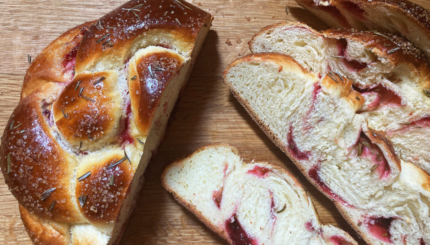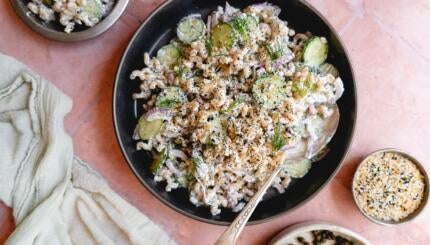“We fought the Greeks, and the victory was ours!” (Traditional Israeli Hanukkah song)
Eating Greek at Hanukkah might seem like a contradiction. After all, at Hanukkah time, there is a stark dichotomy drawn between Jews (good) and Greeks (bad). According to the historical account, Hanukkah celebrates the victory of the small band Maccabees over tremendous military forces of the Syrian Greeks led by Antiochus IV Epiphanes. The Greek culture, with a focus on idol worship and beauty was a clash with Jewish values. So getting rid of the Greeks, rededicating the Holy Temple in Jerusalem to a monotheistic God was a triumph of good over evil.
READ: What You Need to Know About the Hanukkah Story
But on the flip side of this dichotomy are centuries during which Greek-Jewish flourished with Jews living and thriving in Greece. And the Jewish food of Greece can add so much to Hanukkah celebrations.
Greece is not far from the land of Israel, and there was travel and connection between the two countries as far back as 330 C.E. The book of the Maccabees lists several Jewish communities including those in Sparta, Rhodes and Cyprus. These early Jewish Greek settlers came to be known as Romaniyot or Romans.
Over the generations, Greece served as a refuge for Jews from many other places. Jews from Hungary settled in Greece in the 1300 and 1500s bringing their own customs but eventually being absorbed into Greek Jewish life. Another important group of Jewish refugees maintained more of its own historic culture even as it came to dominate and define much of Greek life. In 1453 CE, the Ottoman Turks began to rule over Greece. The Ottoman Empire recognized the Jews as a unique nation with its own religion. Hoping they would help improve the economy, the Ottomans welcomed Jews to Greece just as they did to other parts of their empire. Therefore, beginning in the late 15th century, Greece became a haven for Jews and Anusim (Jews forced to convert to Catholicism during the Inquisition, but maintained secret loyalty to Judaism). These immigrants ushered in a new era of dynamic Jewish life. Jewish music, foods and customs developed with their own unique Greek-Jewish-Sephardic twists.
READ: Jewish Life in the Ottoman Empire
The Holocaust decimated the Greek Jewish community and today there are only small Greek Jewish communities left in Greece itself. Yet in the United States and other places Greek Jews continue to celebrate Hanukkah with strong reminders that move beyond the good/bad paradigm.
You too can join in the Greek Jewish fun by trying out this wonderful recipe for Bunuelos or Bimuelos a fried doughnut that chef Michael Natkin learned to cook when he married into a Greek Sephardic family in Seattle.
For more Hanukkah recipes, click here or go to The Nosher, MyJewishLearning’s food blog.
Natkin explains, these are not typical American doughnuts:
“The dough for bunuelos should be quite wet. This isn’t a doughnut that you roll out. You wet your hands, grab a piece of dough, form a rough ball and poke a hole with your thumb, then drop it straight in the oil. The result is unfussy, light and airy, and altogether insanely delicious. They are so simple to make that you could stir up the dough in just a few minutes before dinner, and fry them up afterwards to entertain and thrill the kids.”
Here is his recipe reprinted with his permission:
Bunuelos (or Bimuelos) with Honey – Sephardic Hanukkah Donuts
Vegan if you use powdered sugar instead of honey
Yields about 14 donuts
- 1 package dry yeast (2 1/4 teaspoons)
- 2 cups warm water, divided
- 1/2 teaspoon salt
- 1 1/2 teaspoons sugar
- 1 tablespoon oil
- 3 1/4 cups all-purpose flour (14.6 ounces)
- oil for deep frying
- honey (or powdered sugar)
- Stir the yeast into 1 cup of the warm water and allow to proof. (If you don’t see bubbles after a few minutes, buy new yeast.) Mix in the remaining cup of water along with the salt, sugar and tablespoon of oil. Slowly stir in the flour, and keep stirring until you have a smooth, wet dough. Cover and allow to rise in a warm spot for at least 1 hour. (I’ve allowed it to go four hours, stirring down occasionally, and it only gets more delicious).
- Put 3 inches of oil in a pot suitable for deep frying and bring to 370 degrees F. Line a tray with paper towels. Get a bowl of water ready.
- Moisten your hands in the bowl of water and grab about 3 tablespoons of the dough. Quickly form it into a rough ball and poke a hole through the center. These are supposed to be rustic, don’t spend any time trying to make them perfect. Drop carefully into the oil. Repeat for as many as will fit comfortably in your pot without crowding. Fry until golden brown on one side, then flip and brown the other side. Use a slotted spoon to remove to paper towels.
- Drizzle with honey (or offer honey for dipping, or dust with powdered sugar) and serve immediately.
Hanukkah
Pronounced: KHAH-nuh-kah, also ha-new-KAH, an eight-day festival commemorating the Maccabees' victory over the Greeks and subsequent rededication of the temple. Falls in the Hebrew month of Kislev, which usually corresponds with December.
Sephardic
Pronounced: seh-FAR-dik, Origin: Hebrew, describing Jews descending from the Jews of Spain.



